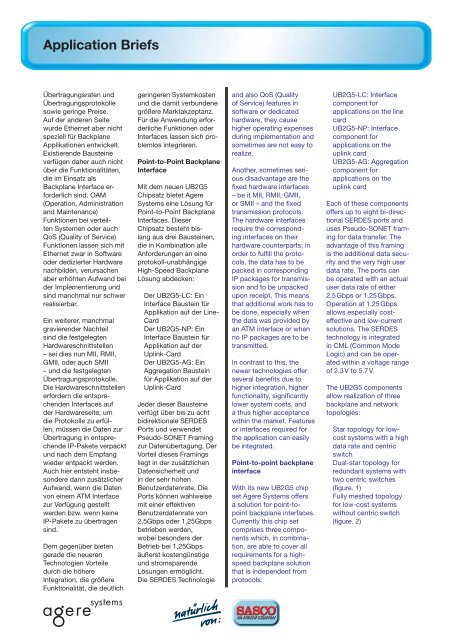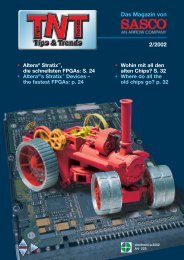steht die TNT als PDF zum Download - ISI-Design
steht die TNT als PDF zum Download - ISI-Design
steht die TNT als PDF zum Download - ISI-Design
Sie wollen auch ein ePaper? Erhöhen Sie die Reichweite Ihrer Titel.
YUMPU macht aus Druck-PDFs automatisch weboptimierte ePaper, die Google liebt.
Application Briefs<br />
Übertragungsraten und<br />
Übertragungsprotokolle<br />
sowie geringe Preise.<br />
Auf der anderen Seite<br />
wurde Ethernet aber nicht<br />
speziell für Backplane<br />
Applikationen entwickelt.<br />
Existierende Bausteine<br />
verfügen daher auch nicht<br />
über <strong>die</strong> Funktionalitäten,<br />
<strong>die</strong> im Einsatz <strong>als</strong><br />
Backplane Interface erforderlich<br />
sind. OAM<br />
(Operation, Administration<br />
and Maintenance)<br />
Funktionen bei verteilten<br />
Systemen oder auch<br />
QoS (Quality of Service)<br />
Funktionen lassen sich mit<br />
Ethernet zwar in Software<br />
oder dedizierter Hardware<br />
nachbilden, verursachen<br />
aber erhöhten Aufwand bei<br />
der Implementierung und<br />
sind manchmal nur schwer<br />
realisierbar.<br />
Ein weiterer, manchmal<br />
gravierender Nachteil<br />
sind <strong>die</strong> festgelegten<br />
Hardwareschnittstellen<br />
– sei <strong>die</strong>s nun MII, RMII,<br />
GMII, oder auch SMII<br />
– und <strong>die</strong> festgelegten<br />
Übertragungsprotokolle.<br />
Die Hardwareschnittstellen<br />
erfordern <strong>die</strong> entsprechenden<br />
Interfaces auf<br />
der Hardwareseite; um<br />
<strong>die</strong> Protokolle zu erfüllen,<br />
müssen <strong>die</strong> Daten zur<br />
Übertragung in entsprechende<br />
IP-Pakete verpackt<br />
und nach dem Empfang<br />
wieder entpackt werden.<br />
Auch hier ent<strong>steht</strong> insbesondere<br />
dann zusätzlicher<br />
Aufwand, wenn <strong>die</strong> Daten<br />
von einem ATM Interface<br />
zur Verfügung gestellt<br />
werden bzw. wenn keine<br />
IP-Pakete zu übertragen<br />
sind.<br />
Dem gegenüber bieten<br />
gerade <strong>die</strong> neueren<br />
Technologien Vorteile<br />
durch <strong>die</strong> höhere<br />
Integration, <strong>die</strong> größere<br />
Funktionalität, <strong>die</strong> deutlich<br />
geringeren Systemkosten<br />
und <strong>die</strong> damit verbundene<br />
größere Marktakzeptanz.<br />
Für <strong>die</strong> Anwendung erforderliche<br />
Funktionen oder<br />
Interfaces lassen sich problemlos<br />
integrieren.<br />
Point-to-Point Backplane<br />
Interface<br />
Mit dem neuen UB2G5<br />
Chipsatz bietet Agere<br />
Systems eine Lösung für<br />
Point-to-Point Backplane<br />
Interfaces. Dieser<br />
Chipsatz be<strong>steht</strong> bislang<br />
aus drei Bausteinen,<br />
<strong>die</strong> in Kombination alle<br />
Anforderungen an eine<br />
protokoll-unabhängige<br />
High-Speed Backplane<br />
Lösung abdecken:<br />
• Der UB2G5-LC: Ein<br />
Interface Baustein für<br />
Applikation auf der Line-<br />
Card<br />
• Der UB2G5-NP: Ein<br />
Interface Baustein für<br />
Applikation auf der<br />
Uplink-Card<br />
• Der UB2G5-AG: Ein<br />
Aggregation Baustein<br />
für Applikation auf der<br />
Uplink-Card<br />
Jeder <strong>die</strong>ser Bausteine<br />
verfügt über bis zu acht<br />
bidirektionale SERDES<br />
Ports und verwendet<br />
Pseudo-SONET Framing<br />
zur Datenübertagung. Der<br />
Vorteil <strong>die</strong>ses Framings<br />
liegt in der zusätzlichen<br />
Datensicherheit und<br />
in der sehr hohen<br />
Benutzerdatenrate. Die<br />
Ports können wahlweise<br />
mit einer effektiven<br />
Benutzerdatenrate von<br />
2,5Gbps oder 1,25Gbps<br />
betrieben werden,<br />
wobei besonders der<br />
Betrieb bei 1,25Gbps<br />
äußerst kostengünstige<br />
und stromsparende<br />
Lösungen ermöglicht.<br />
Die SERDES Technologie<br />
and <strong>als</strong>o QoS (Quality<br />
of Service) features in<br />
software or dedicated<br />
hardware, they cause<br />
higher operating expenses<br />
during implementation and<br />
sometimes are not easy to<br />
realize.<br />
Another, sometimes serious<br />
disadvantage are the<br />
fixed hardware interfaces<br />
– be it MII, RMII, GMII,<br />
or SMII – and the fixed<br />
transmission protocols.<br />
The hardware interfaces<br />
require the corresponding<br />
interfaces on their<br />
hardware counterparts; in<br />
order to fulfill the protocols,<br />
the data has to be<br />
packed in corresponding<br />
IP packages for transmission<br />
and to be unpacked<br />
upon receipt. This means<br />
that additional work has to<br />
be done, especially when<br />
the data was provided by<br />
an ATM interface or when<br />
no IP packages are to be<br />
transmitted.<br />
In contrast to this, the<br />
newer technologies offer<br />
several benefits due to<br />
higher integration, higher<br />
functionality, significantly<br />
lower system costs, and<br />
a thus higher acceptance<br />
within the market. Features<br />
or interfaces required for<br />
the application can easily<br />
be integrated.<br />
Point-to-point backplane<br />
interface<br />
With its new UB2G5 chip<br />
set Agere Systems offers<br />
a solution for point-topoint<br />
backplane interfaces.<br />
Currently this chip set<br />
comprises three components<br />
which, in combination,<br />
are able to cover all<br />
requirements for a highspeed<br />
backplane solution<br />
that is independent from<br />
protocols:<br />
• UB2G5-LC: Interface<br />
component for<br />
applications on the line<br />
card<br />
• UB2G5-NP: Interface<br />
component for<br />
applications on the<br />
uplink card<br />
• UB2G5-AG: Aggregation<br />
component for<br />
applications on the<br />
uplink card<br />
Each of these components<br />
offers up to eight bi-directional<br />
SERDES ports and<br />
uses Pseudo-SONET framing<br />
for data transfer. The<br />
advantage of this framing<br />
is the additional data security<br />
and the very high user<br />
data rate. The ports can<br />
be operated with an actual<br />
user data rate of either<br />
2.5 Gbps or 1.25 Gbps.<br />
Operation at 1.25 Gbps<br />
allows especially costeffective<br />
and low-current<br />
solutions. The SERDES<br />
technology is integrated<br />
in CML (Common Mode<br />
Logic) and can be operated<br />
within a voltage range<br />
of 2.3 V to 5.7 V.<br />
The UB2G5 components<br />
allow realization of three<br />
backplane and network<br />
topologies:<br />
• Star topology for lowcost<br />
systems with a high<br />
data rate and centric<br />
switch<br />
• Dual-star topology for<br />
redundant systems with<br />
two centric switches<br />
(figure. 1)<br />
• Fully meshed topology<br />
for low-cost systems<br />
without centric switch<br />
(figure. 2)




